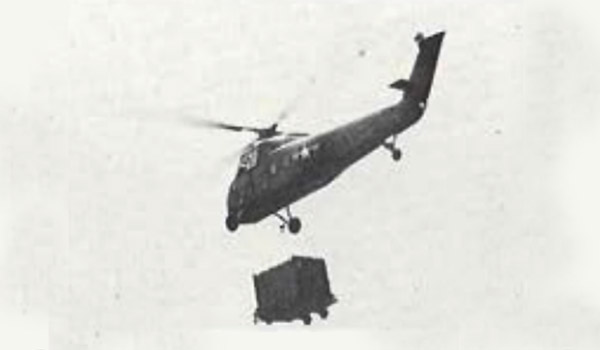
Development of a new highly mobile, air transportable communications center, designed to direct fast moving U.S. Army forces was announced recently by the Department of the Army.
The system, which has an extremely high degree of mobility, can be set down almost anywhere by helicopters, and be flown out immediately for relocation elsewhere. It can also be move rapidly from place to place on conventional Army trucks.

A helicopter soars away with part of the airborne combat communications center. Inside the shelter is a complete teletypewriter room with facilities to service an area hundereds of miles wide. other shelters, all light enough to be carried by helicopter, carry radio, telephone, telegraph, and other vital communications links.
Developed by the U.S. Army Signal Corps, it provides the vital nucleus for a communications network radio, telephone, telegraph and teletypewriter combat links.
The system can be carried by helicopters to a remote destination in hours rather than days, or can be set up on otherwise inaccessible mountain tops. With its communications tentacles spread over hundreds of miles, the new system can get an urgent message through to a distant outpost even with direct lines broken or destroyed.
Speed and flexibility in communications would be vital on a battlefield where troops would have to be continuously on the move and widely dispersed to avoid annihilation by a nuclear warhead.

Radio equipment inside the US Army’s airborne communications center is operated by PFC David C. Wuesimann of Ft. Monmouth, where the center was designed by the US Army Signal Research and Development Laboratory.
For quick transportation and added versatility, the center is made up of separate aluminum houses or “shelters,” each fully equipped and independent. Three can be hooked up quickly to fit any battle situation. Small centers for the front lines would have two or three shelters; larger headquarters would have as many as 24.
Each shelter carries its own independent supply of electricity, but can also plug into a central power source.
High priority combat messages flowing into the center from combat groups and other sources would be immediately available to the Army field commander. And the same network of communications lines carries his messages with reflex speed to higher headquarters on to hard-hitting Army combat elements.
The new system, the first fully air transportable message center of its kind, is the result of 12 years of design and research.
Source: See page 8, Army Aviation, Vol. 7, No. 1, Army Aviation Publications, Inc., Westport, Connecticut, January 24, 1959.










